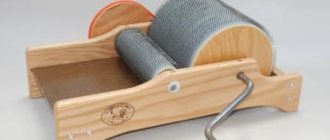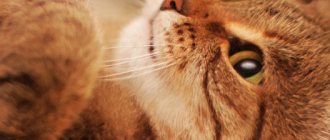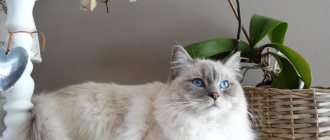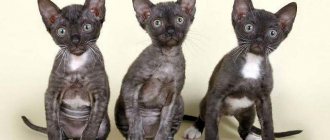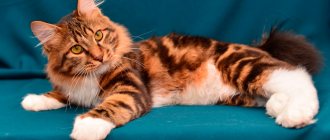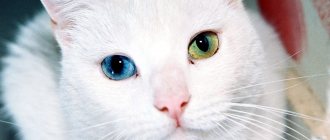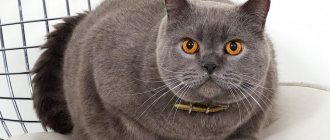Principle of operation
The Furminator is a special comb with a trimmer for combing out fur. It is equipped with a comb-shaped blade and an ergonomic rubberized handle. The distance between the teeth of the device, their size and number may vary. This depends on the length of the cat's hair, as well as the size of the animal.
The principle of operation of the furminator is that when it moves through the pet’s fur, the hairs are raised and harmful parts are removed at a given height without cutting or pulling out.
In this case, the guard hairs slip through the teeth of the device and remain intact, while the fallen, dead hairs of the main coat and undercoat remain on the teeth.
Manufacturers guarantee the removal of most unwanted hair (up to 90%) and reduction of seasonal shedding by at least half due to timely and complete hair removal in one combing.
An additional advantage of the device is that when used, natural fatty lubricant is evenly distributed over the surface of the fur, protecting the cat's axial hair and undercoat from external adverse influences - dirt, dust, water, parasites (fleas).
My review or benefits of use:
- reduction in the amount of hair that falls out by 90-95% and the absence of tangles;
- improvement in the appearance of the coat - when using the furminator, the fatty lubricant is evenly distributed, which contributes to the smoothness and shine of the coat;
- the furminator brush carefully pulls out the dead undercoat, without damaging the “living” hair and the quality of the coat does not suffer - this is very important for owners of show breed cats;
- The furminator is a professional grooming tool that you can easily use at home, while receiving salon care for your cat’s fur.
Advantages
Manufacturers of furminators advertise their products, listing the following advantages when used for combing cats:
- there is no injury to the animal’s skin;
- do not cause pain to the cat;
- healthy guard hairs are not damaged during the combing process;
- removal occurs in the right places and only dead parts of the undercoat;
- using the device helps prevent the occurrence of tangles;
- the animal gets used to combing painlessly and quickly;
- the pet enjoys the procedure;
- due to the effective removal of loose hair, the cat swallows less hair when licking;
- the molting period is effectively reduced;
- at the same time the skin is massaged;
- The source of pollution in human housing is promptly eliminated.
We also recommend reading the article on how to comb cats.
For the British
Each cat breed has its own characteristics, including external ones. For example, British representatives require special care, and therefore many different tools have been invented for them. One of the most effective is the Furminator for British cats. Reviews say that this is an integral tool, necessary when high-quality care for furry pets is required.
Another useful device for caring for British cats is a device for combing out the undercoat - ELiminator DUO. This is a French-made tool that combines the functions of a furminator and a comb, making it a worthwhile investment. And with a special FurMaster grooming brush, you can painlessly remove dead undercoat without causing harm to the animal’s skin.
Device selection
Many manufacturers produce various models of furminators, differing in the set of devices and functions they perform. But their main difference is what animal they are designed for.
For long-haired cats
The peculiarity of such wool and the difficulty of caring for it is that the undercoat is usually thin and soft and the hairs that come out form clumps. During the molting period, they fly around the rooms, get into the eyes and respiratory tract of household members, irritate, often cause allergies, and settle on furniture and clothing.
In this case, the guard hair gets tangled with the remaining undercoat and falls off, forming unsightly tangles. They are always difficult to remove; you often have to cut them, which affects the appearance of the cat.
Furminators for long hair easily cope with both of these problems, because:
- The teeth of the trimmer comb are long enough, they easily reach problem areas, allowing you to avoid damaging the skin and healthy hair.
- The teeth are located at a greater distance from each other, which also allows you to comb the animal without damaging the fur.
- There are special models that take into account the age and size of the cat. So, there is a special device for an adult cat and a small kitten of the Persian breed, which has the longest and thickest hair.
- All this data is indicated in the technical specifications for the device.
Models for long hair have the word Large in the name. They are available in two modifications. The first is intended for cats with hair up to 10 cm and weighing up to 10 kg. The second is designed for fur lengths over 12.5 cm.
For short-haired breeds
Such animals have a different problem when molting. The hairs are usually short and coarse. They quickly get stuck in clothes, on upholstery and blankets, and are quite difficult to remove.
For cats with short hair, furminators have the following functions:
- The teeth of the trimmer comb are shorter than for breeds with long hair.
- The comb has finer teeth designed for short fluff.
- There are special models for different types of wool - hard without undercoat (for example, Abyssinian) and densely padded (British and Scottish cats).
- Models have been created for animals of different ages and sizes.
Available in Small and X-Small versions. The first model is intended for cats weighing up to five kilograms and with a hair length of 4.5 centimeters. The second is for very small animals and kittens (hair -3.3 centimeters).
The Medium modification has a tooth length of 6.7 cm, the weight of the animal for which the device is designed is up to 10 kg.
When purchasing a furminator you should also consider:
- brand of the manufacturer;
- the quality of the material from which the device is made;
- price.
All modifications are carried out in the classic and deluxe categories, differing only in the design and material of the handles. In addition, the second option has a special ejector button that allows you to remove hairs from the comb not manually, but automatically.
The structure of cat fur
The fur of cats and dogs is a kind of hair. Periodically, the formation of new hair stops. After some time, the old hair falls out - shedding occurs. Then cell division of the hair follicle resumes, and new hair grows.
There are several types of shedding:
- Seasonal, associated with the change of season. It is typical for animals living on the street. All wool is renewed almost simultaneously.
- Permanent, in those individuals that live in the house. There is a periodic, gradual replacement of wool throughout the year.
- Physiological. This is a temporary process associated with certain periods: estrus, mating, pregnancy, feeding kittens.
Lost hair is everywhere in the apartment, creating inconvenience for owners and cats. To solve this problem, there are furminators for cats. To understand why to use them, it is necessary to consider the structure of the coat of cats.
Hair follicles in cats have a complex structure. From each follicle grow:
- The awn is the primary, or central (covering) hair. It is the thickest and longest, called the guide.
- 2-3 thinner and shorter hairs that surround the hair guide.
- Hair, even shorter, forming the undercoat.
- Downy hair.
The furminator for cats greatly simplifies this labor-intensive process.
Cats have the thickest fur. Its density varies in different parts of the body. The thickest, short covering hair—almost just fluff with undercoat—is located on the belly. The hair on the back is longer and thicker, but there is less of it.
How to use a furminator
In order to quickly, efficiently and correctly comb an animal using a furminator, first of all, you should read the instructions and follow the rules:
- carefully examine the cat first;
- using a special device, remove all existing tangles;
- It is better to bathe the pet, dry it and comb it with a comb;
- pick up the furminator and start combing strictly in the direction of hair growth;
- comb with light movements, without pressing on the cat’s body;
- treat the most delicate places especially carefully - the stomach, genitals and adjacent areas, paws;
- Initially, it is advisable to use the device during the molting period (early spring and autumn) - at this time dead hairs are removed more easily;
- during seasonal shedding, two brushings per week are sufficient for any breed;
- outside of shedding, long-haired cats are brushed with a furminator once a month;
- short-haired - once every two months;
- To alleviate the animal’s condition, it is advisable to carry out an additional procedure in the hot season.
Cat hair care
Now it becomes clear that without a cat brush it is difficult to care for its fur. Dead hairs must be removed regularly, otherwise mats will form in long-haired and fluffy breeds. The animal licks off most of the old hair, which threatens to disrupt the patency of the esophagus.
It's difficult to care for your cat's fur without a cat brush.
Each cat breed has its own coat type. The British have a awn and down of the same length, Persians have a thick undercoat. There is no down in Siamese-Oriental breeds; Siberians have long hair with a double undercoat. Astrakhan-like fur is characteristic of rexes, while sphinxes have barely noticeable fluff.
Mr. Cat recommends: for whom the furminator is contraindicated
Furminator should not be used if there are scratches, wounds, irritations, or any skin diseases on the cat’s body.
There is no point in using this device for hairless cats:
- Canadian Sphynx;
- Don Sphynx;
- Peterbald;
- Ukrainian Levkoy;
- Elf;
- Dwelf;
- Bambino.
When caring for cats with very short hair that does not have undercoat and lies tightly to the body, you should also not use a furminator:
- Bengal;
- Toyger;
- Abyssinian;
- Burmanskaya;
- Laperm;
- Devon Rex;
- Singaporean;
- Oriental.
This procedure will not harm them. If you wish, you can purchase the device, but you need to use it half as often.
Pros and cons of combs
The main advantage of the furminator is durability. Strong steel is used to make the teeth, so they do not become dull. Regular combs need to be changed once a year.
Positive qualities include:
- faster and easier combing process;
- in one session you can remove about 90 - 95% of dead hairs;
- the furminator is safe for cat fur, since it does not affect the outer hair and only removes hairs from the dead undercoat;
- the tips of the teeth of the device are blunt, so it cannot injure the pet’s skin;
- Thanks to the special structure of the teeth, the furminator can penetrate deep into the undercoat.
The downside is the high cost of the original tool.
Review of popular models
The most popular furminator models on the modern market, which have deservedly received the highest ratings from users:
- FURminator deShedding;
- HelloPet;
- TRIXIE;
- Dele.
It is better to purchase the first three brands in specialized stores or grooming salons to avoid counterfeits.
FURminator deShedding
It is considered the most expensive and high quality. The material of the trimmer teeth is high quality steel. The handle is made of eco-rubber with a special application according to the “anti-slip” formula.
In the “classic” version, the cost of the device is about 1,800 rubles.
The “deluxe” modification with an ejector button for removing hair from teeth ranging from 2,100 to 3,000. The comb sizes are available for kittens, small animals and large cats. Due to high-strength materials, it has a long service life.
Trimmer comb TRIXIE
Made from materials with a shorter service life, but has a better price-quality ratio and enjoys well-deserved popularity. The cost of the product, depending on the size of the comb and teeth, is from 900 to 1,500 rubles.
The overall dimensions of the product are 7×15 centimeters. The handle is made of rubberized material and does not slip. Users note the lightness of the device and its ease of use.
HelloPet
Equipped with a handle and trimmer blade made of impact-resistant materials. The comb width is 65 mm, the number of teeth is from 60 to 97 for animals of different types of wool and dimensions. The cost of the device, depending on the size and frequency of the trimmer comb, is from 1,200 to 1,800 rubles.
Dele
This popular Chinese product can be bought on Aliexpress. Available in modifications S, M and L, having blade lengths of 5, 6.6 and 10 centimeters, respectively.
A small and lightweight device will last much less than the expensive FURminator, but its advantage is ease of use and low cost.
The cost, depending on the modification, is from 380 to 515 rubles.
Expert advice
How often can you use the tool? Every day, but there is no real need for this. Cats can be combed once or twice a week for 15-20 minutes. This is quite enough to shorten the molting period.
Does the Furminator cut hair? The original tool does not cause any damage. It only removes dead undercoat hairs.
Does the use of a tool prevent the formation of tangles? Yes, regular brushing of the undercoat shortens the shedding period and reduces the number of dead hairs that become tangled and form clumps of matted fur.
Is combing done in winter? Yes. The Furminator removes only dead hairs from the undercoat. It completely retains its original thickness. Don't worry - your pet won't freeze because of this.
Is a furminator used to remove tangles? No, for this there is a special device called a tangle cutter. Before starting the combing procedure, you need to make sure that all clumps of matted hair have been removed.
